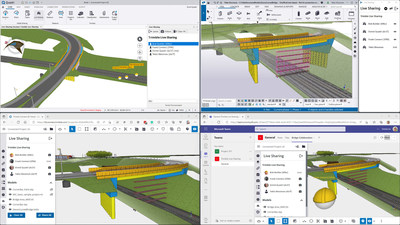One of the buzzwords of the 21st Century that has led to productivity and confusion in equal amounts has been The Cloud. That ambiguous repository of IT data and applications known as a cloud has been the basis of many digital transformations at companies in all industries, not the last construction. Major suppliers, application vendors, and technology companies are in The Cloud, and more are joining them monthly.
Take for example Trimble, a company noted for its core technologies in positioning, modeling, connectivity, and data analytics that connect the digital and physical worlds to improve productivity, quality, safety, transparency, and sustainability. And an even more familiar company, Microsoft which has been part of the IT ecosystem since the 1980s. Together, they have launched Trimble Construction Cloud powered by Microsoft Azure, an industry cloud to streamline construction projects.

Trimble Construction Cloud was developed as part of Trimble’s collaboration with Microsoft to advance technology adoption and accelerate the digital transformation of the construction, agriculture, and transportation industries. Trimble Construction Cloud takes advantage of Microsoft Azure services including Logic Apps, Azure DevOps, and Azure Kubernetes Service.
The platform links project teams, data, processes, and multiple stakeholders—such as general contractors, subcontractors, designers, engineers, and owners—across all phases of construction projects. This enables projects to be completed better, faster, safer, cheaper, and greener. By providing seamless collaboration from the field to the back office, Trimble Construction Cloud provides an environment where transparency and actionable data are the norm.
It is also the sole construction industry cloud for Microsoft customers.
Apps in The Cloud
Trimble Construction Cloud will launch as the cloud solution powering Trimble Construction One, a purpose-built connected construction management platform that includes Viewpoint Vista ERP, field data, estimating, detailing, project management, finance, equipment, and human capital management solutions.
As an example, the Hilti Group, a leader in providing innovative tools, technology, software, and services to the commercial construction industry, has integrated Hilti ON!Track asset management system with Trimble Viewpoint Vista.
The integration is Hilti’s first North American integration with an ERP (enterprise resource planning) solution and provides a solution for unified tool tracking and more accurate, automatic job allocation, giving contractors one source of truth for tracking and managing their tools and equipment.
Now instead of having to manually look, call or guess where tools are or how much to invoice based on their use, contractors can more easily track their tools and equipment in one place and automatically know how much—and where—they were used so that an accurate amount of equipment time can be invoiced. This eliminates the need to spend clerical time manually in putting utilization data, and even manually tracking it in the field.
Construction in The Cloud
Trimble Construction Cloud includes four main functions designed to automate the flow of data and decision-making for more efficient and predictable business outcomes:
Common Data Environment: Task-specific point solutions have created the fragmentation of data and losses in handoffs, as construction is increasingly a mixed fleet world with different equipment, technology, software, and information—each of which handle different parts of the construction lifecycle. Trimble Construction Cloud features one centralized, common data environment that connects the office with site operations tools, enabling Trimble and non-Trimble solutions to automatically integrate into one usable data set. This provides enhanced data visibility and unites stakeholders across jobs, teams, and departments with the right information at the right time to make the right decisions.
Configured and Custom Workflows: Despite the number of repetitive tasks inherent to construction, most contractors still run their businesses manually, which is time-consuming and error prone. Trimble Construction Cloud solves this challenge with configured and customizable workflows that help project teams automate different aspects of their business with commonly used workflows, as well as by building and deploying their own around critical job roles and specific business objectives.
The cloud’s three configured workflows include a model-to-procurement built for MEP (mechanical, engineering and plumbing); a model-to-fabrication for structures; and a civil bid-to-build for site management.
Live Data/Model Sharing: Trimble Construction Cloud provides customers with the ability to subscribe to unique capabilities across Trimble and non-Trimble solutions, such as Microsoft Teams, that serve to enhance and facilitate collaboration across project teams. Non-Trimble Construction One users can subscribe to Trimble Construction Cloud independently as a separate service.
The Live Sharing capability allows for real-time model collaboration for both Trimble and non-Trimble solutions. With Live Sharing, multiple users can be in several Trimble solutions—such as Quadri, Trimble Connect, and Tekla—and view model changes as they happen. Users with non-Trimble solutions can also collaborate in the same modeling process as well.
Trimble Developer Portal: Instead of reaching out to various organizations within a business to gain access to a report or specific type of data, Trimble Construction Cloud centralizes the discovery, learning, provisioning, support, and successful application of APIs through the Trimble Developer Portal, an easily accessible, centralized portal designed to facilitate faster onboarding and integration leading to more productive developer experiences.
Want to tweet about this article? Use hashtags #construction #sustainability #infrastructure #IoT #cloud #edge #futureofwork


